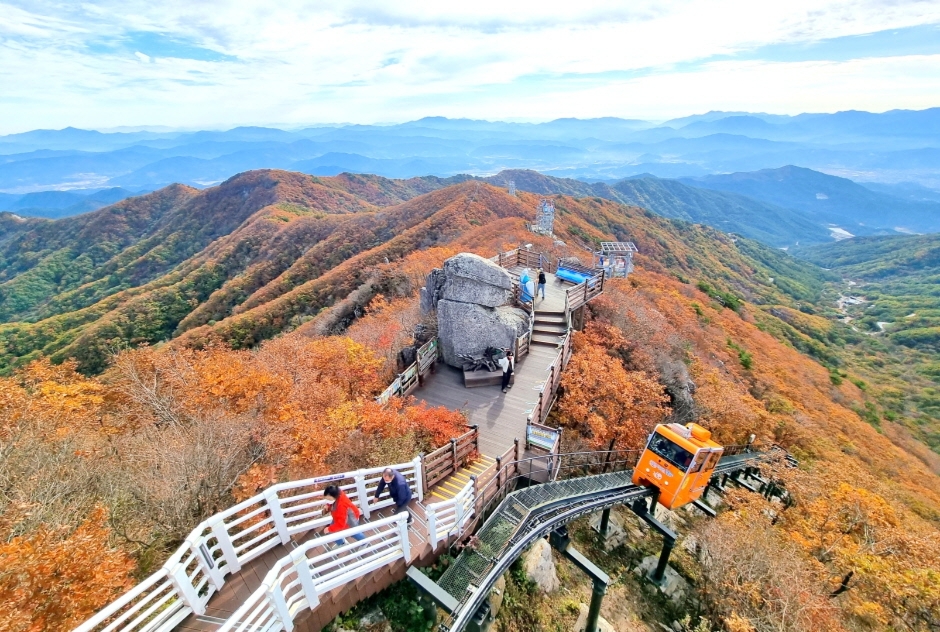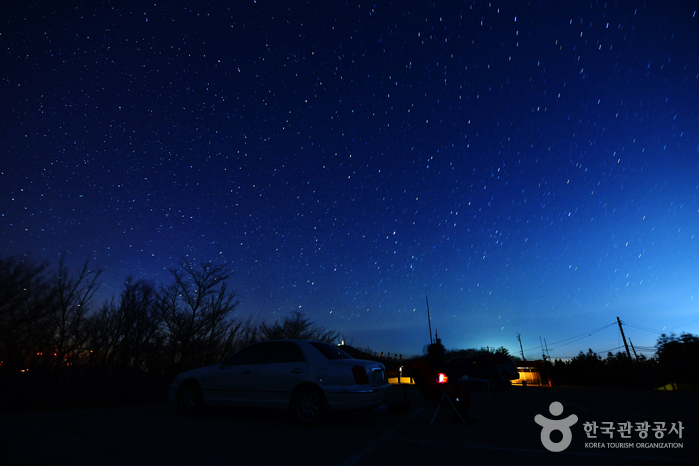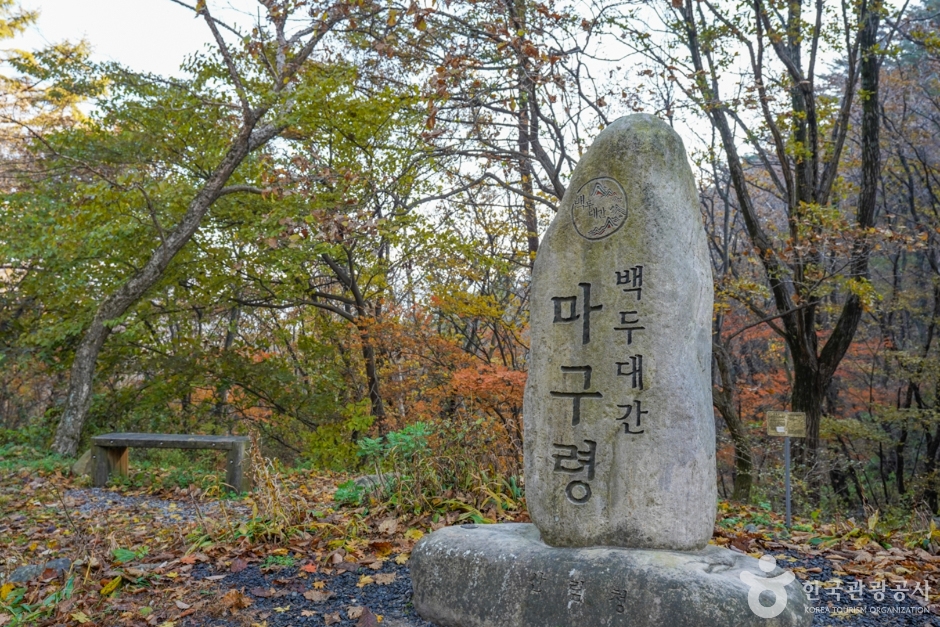Hamyang Daebong Mountain Valley Resort (함양대봉산휴양밸리)
2025-01-17
331 Byeonggokjigok-ro, Byeonggok-myeon, Hamyang-gun, Gyeongsangnam-do
Hamyang Daebong Mountain Valley Resort is a recreation and tourism complex at the foot of Daebongsan Mountain in Hamyang. This resort boasts an array of attractions, including a mountain monorail and a zipline, offering exhilirating experiences amidst natural beauty. Addtionally, guests can enjoy various accommodation and and camping facilities, along with a forest park, blending adventure and relaxation seamlessly. The zipline itself, positioned 1,200 meters above sea level, spans an impressive length of 3.27 kilometers, providing an unforgettable aerial journey over the landscape.
Yeongcheon Starlight Village (영천 별빛마을)
2024-02-23
22 Jeonggak-gil, Hwabuk-myeon, Yeongcheon-si, Gyeongsangbuk-do
Nestled at the foot of Bohyeonsan Mountain, Yeongcheon Starlight Village is a haven of natural beauty, surrounded by lush forests brimming with pine and chestnut trees. The village provides a range of accommodations and experiential programs, featuring guest rooms, seminar rooms, multipurpose spaces, and a cultural center. Its proximity to Bohyeonsan Mountain allows visitors to explore the enchanting Bohyeonsan Starlight Trail. In spring, visitors can also attend the Yeongcheon Bohyeonsan Starlight Festival, a celebrated annual event dedicated to astronomy and science. Additional local attractions include the Cian Art Museum, Unjusan Recreational Forests, Yeongcheon Dam, and the Bohyunsan Astronomical Science Museum.
Cheonghak-dong Etiquette School Seonbi Seodang (청학동예절학교 선비서당)
2024-03-04
60-10 Wonmuk-gil, Cheongam-myeon, Hadong-gun, Gyeongsangnam-do
Cheonghak-dong, located at the foot of the ridge facing Hadong on Jirisan Mountain, is a village inhabited by 200 residents from thirty families. It hosts several seodangs (village schools), among which Seonbi Seodang stands out for its educational programs focusing on etiquette, character development, and Chinese characters. Additionally, the village offers a variety of experience programs, including traditional culture, farming activities, and perseverance training.
Maguryeong Pass / Gochiryeong Pass (마구령/고치령)
2024-02-23
[Maguryeong Pass] Imgok-ri, Buseok-myeon, Yeongju-si, Gyeongsangbuk-do
Maguryeong Pass and Gochiryeong Pass stand as iconic hills of Sobaeksan Mountain. They are known for their historical significance as rugged pathways where people and goods traversed during the Goryeo and Joseon dynasties. Situated on the easternmost edge of Sobaeksan Mountain, Maguryeong Pass derives its name from its function: "Magu" meaning "harness" and "Ryeong" meaning "pass" in Korean, highlighting its past as a route where merchants commonly traveled on horseback. Meanwhile, Gochiryeong Pass served as a vital transport link to the Gwandong and Hoseo regions. In the Silla dynasty, this pass was earmarked for palace construction at the base of the hill, which led to its name "Gochiryeong" – "Go" indicating "old", "Chi" representing "hill", and "Ryeong" meaning "pass" in Korean – effectively translating to "old hill pass".
Yeongju Modern History & Culture Street (영주근대역사문화거리)
2024-02-23
Yeongju-dong, Yeongju-si, Gyeongsangbuk-do
Yeongju Modern History and Culture Street serves as a historical and cultural hub, encapsulating the life and times of early twentieth-century Yeongju. The street is dotted with cultural properties officially recognized by the Cultural Heritage Administration. Highlights include the preserved official residences No. 5 and No. 7 of Yeongju Station, once home to railway station employees. Additionally, visitors can explore the Pungguk Rice Mill, showcasing vintage rice milling machinery; Yeongju Jeil Church, a 1909-built structure exemplifying Gothic-style architecture; Yeongju-dong Modern Hanok, a subsidiary structure of an ancient residence; and the still-operating Yeonggwang Barber Shop, a testament to the area's enduring heritage.
Hamyang Jianjae Pass (함양 지안재)
2024-10-10
119-3 Guryong-ri, Hamyang-eup, Hamyang-gun, Gyeongsangnam-do
Jianjae Pass, renowned for its picturesque winding roads, is a celebrated attraction in Hamyang. It was also selected as one of the "100 Most Beautiful Roads in Korea." While the pass is navigable by car, it's best appreaciated by stopping to soak in the views from the observation deck. An observatory is situated at the end of Jianjae Pass, providing visitors with an excellent vantage point for capturing stunning photographs.
Seoamjeongsa Temple (서암정사(함양))
2024-02-21
27-79 Gwangjeom-gil, Macheon-myeon, Hamyang-gun, Gyeongsangnam-do
Seoamjeongsa Temple belongs to Byeoksongsa Temple, which is at the entrance of the Chilseongyegok Valley of Jirisan Mountain. Monk Woneung rebuilt Byeoksongsa Temple, which had been damaged during the Korean War in 1950. This hermitage features the Buddha statues Woneung carved into the natural bedrock, a grotto sanctuary with statues of the Pure Land, Daebanggwangmun Gate, and Sajagul Cave.
Burilpokpo Falls (불일폭포)
2024-02-08
103 Mogap-gil, Hwagae-myeon, Hadong-gun, Gyeongsangnam-do
Situated 720 meters above sea level, Burilpokpo Falls stands as the tallest waterfall on Jirisan Mountain, boasting a x_height of 60 meters and a x_width of 3 meters. It features a distinctive two-tier structure, with the enchanting Yongchumot and Hangmot Ponds nestled below, adding to its profound natural allure. Conveniently located just 3 kilometers from Ssanggyesa Temple, it's an ideal spot to visit following a trip to the temple.
Samseonggung (삼성궁)
2024-02-21
86-15 Samseonggung-gil, Cheongam-myeon, Hadong-gun, Gyeongsangnam-do
Samseonggung is a Taoist shrine located at 850 meters above sea level on Jirisan Mountain. It serves as a spiritual hub for practicing Sinseondo, embodying traditional Korean culture. In 1983, Kang Min-ju (Taoist Priest Hanpul), along with his disciples, restored the sodo, a sacred altar from the Gojoseon period. This shrine stands as a revered sanctuary, honoring the primal ancestors of the Korean people: Hwanin (Lord of Heaven), Hwanung (Supreme Divine Regent), and Dangun (legendary founder of Gojoseon).
Tongyeong Lighthouse Fishing Park (통영등대낚시공원)
2024-02-08
441 Samchingihaean-gil, Sanyang-eup, Tongyeong-si, Gyeongsangnam-do
Tongyeong Lighthouse Fishing Park is a bridge-shaped fishing facility, conveniently situated near the Donam Tourist Complex in Tongyeong. It was established in 2006 when Tongyeong was selected as a pilot site for the Marine Fishing Park project initiated by Gyeongsangnam-do. Known as an ideal spot for sea fishing, it offers stunning views of the Hallyeo National Marine Park. This location allows visitors to enjoy sea fishing safely without the need to venture far out to sea by boat.




 English
English
 한국어
한국어 日本語
日本語 中文(简体)
中文(简体) Deutsch
Deutsch Français
Français Español
Español Русский
Русский